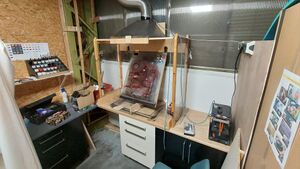Airbrush Area: Difference between revisions
No edit summary |
added PDF with some basic airbrush exercises |
||
| (18 intermediate revisions by 3 users not shown) | |||
| Line 1: | Line 1: | ||
[[File:airbrush area.jpg|thumb|right|the airbrush area when it was opened in April 2024]] | |||
The airbrush area is located in the [[Location::Electronics Room|electronics room]] and contains our [[airbrushing]] related tools and machines. Not just for creating beautiful airbrush art, but also for painting [[3DP|3D-printed]] models and other materials. Using an airbrush is easy, fun to learn – and a lot better for the environment than [[Spray Paint|spray cans]]. | |||
=== Airbrush | ===Airbrush Colors=== | ||
Dedicated airbrush paints are usually water-based acrylic paints, with a milk-like consistency. | |||
''See [[Material:Airbrush Paint]] for more information and experiences!'' | |||
=== | ===Spray Booth and Air Extraction=== | ||
Make sure you always have the spray booth's air extractor turned to on to "max Level" (Level 3) when the airbrush is in use (don't forget to use ear protection). The easiest method would be to keep the extractor running throughout your entire session, even if you take a break. That way, you don't forget to turn it on. Always keep the curtain behind you closed. Aerosols can travel for quite a long distance across the room, and we'd like to keep the other equipment free of paint. Once you've finished your session (whilst cleaning the airbrush): keep the air extractor running for a few more minutes and open the curtain and the door, to allow for additional air exchange in the room. | |||
The spray booth we've built should be large enough to accomodate most needs, be it a A1-sized airbrush painting, or a t-shirt, shoes etc. | |||
At the rear of the spray booth, you'll see a metal plate which can be tilted towards you, for a convenient viewing angle. For painting miniature figures / 3D-printed models etc: you'll find a turntable in one of the drawers. Also: Working with the airbrush is a lot more convenient if you lift your model up (to just below eye level). Positive side-effect: This also increases air ectraction efficiency. | |||
== Access == | |||
To use the machines in the airbrush area, you need to get an [[Airbrush Introduction|airbrush introduction]]. | |||
== Airbrush Exercises == | |||
Here is a PDF with some basic airbrush exercises. Download, print and attach them to the backdrop in the spray booth. (Airbrushing onto a vertical canvas is easier than placing the canvas onto a horizontal surface). Even professional airbrush artists do warm-up exercises before they start a project. | |||
[[File:Airbrush Practice Sheet.pdf|alt=Airbrush practice sheet|thumb|Airbrush practice sheet]] | |||
[[Category:Airbrushing]] | |||
[[Category:Facilities]] | |||
Revision as of 17:44, 4 May 2024

The airbrush area is located in the electronics room and contains our airbrushing related tools and machines. Not just for creating beautiful airbrush art, but also for painting 3D-printed models and other materials. Using an airbrush is easy, fun to learn – and a lot better for the environment than spray cans.
Airbrush Colors
Dedicated airbrush paints are usually water-based acrylic paints, with a milk-like consistency.
See Material:Airbrush Paint for more information and experiences!
Spray Booth and Air Extraction
Make sure you always have the spray booth's air extractor turned to on to "max Level" (Level 3) when the airbrush is in use (don't forget to use ear protection). The easiest method would be to keep the extractor running throughout your entire session, even if you take a break. That way, you don't forget to turn it on. Always keep the curtain behind you closed. Aerosols can travel for quite a long distance across the room, and we'd like to keep the other equipment free of paint. Once you've finished your session (whilst cleaning the airbrush): keep the air extractor running for a few more minutes and open the curtain and the door, to allow for additional air exchange in the room.
The spray booth we've built should be large enough to accomodate most needs, be it a A1-sized airbrush painting, or a t-shirt, shoes etc.
At the rear of the spray booth, you'll see a metal plate which can be tilted towards you, for a convenient viewing angle. For painting miniature figures / 3D-printed models etc: you'll find a turntable in one of the drawers. Also: Working with the airbrush is a lot more convenient if you lift your model up (to just below eye level). Positive side-effect: This also increases air ectraction efficiency.
Access
To use the machines in the airbrush area, you need to get an airbrush introduction.
Airbrush Exercises
Here is a PDF with some basic airbrush exercises. Download, print and attach them to the backdrop in the spray booth. (Airbrushing onto a vertical canvas is easier than placing the canvas onto a horizontal surface). Even professional airbrush artists do warm-up exercises before they start a project. File:Airbrush Practice Sheet.pdf